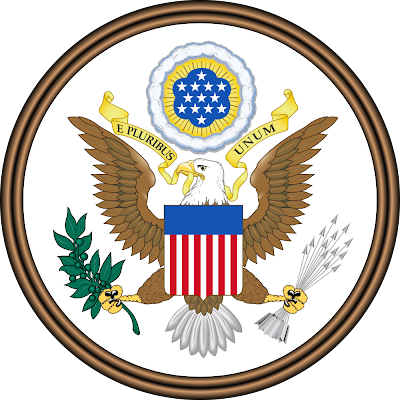June 20, 1782, Congress adopts the Great Seal of the United States
Symbolically, the seal reflects the beliefs and values that the Founding Fathers attached to the new nation and wished to pass on to their descendants. The report which Thomson submitted to the Congress explained the obverse this way: The red and white stripes of the shield “represent the several states... supporting a [blue] Chief which unites the whole and represents Congress.” The colors are adopted from the American flag: “White signifies purity and innocence, Red, hardiness & valour, and Blue, the colour of the Chief, signifies vigilance, perseverance & justice.”
The shield, or escutcheon, is “born on the breast of an American Eagle without any other supporters to denote that the United States of America ought to rely on their own Virtue.” The number 13, denoting the 13 original States, is represented in the bundle of arrows, the stripes of the shield, and the stars of the constellation. The olive branch and the arrows “denote the power of peace & war.” The constellation of stars symbolizes a new nation taking its place among other sovereign states. The motto E Pluribus Unum, emblazoned across the scroll and clenched in the eagle’s beak, expresses the union of the 13 States.
  | Recent scholarship has pointed out the probable source of this motto: Gentlemen’s Magazine, published in London from 1732 to 1922, was widely read by the educated in the American Colonies. Its title page carried that same motto and it is quite possible that it influenced the creators of the seal. The reverse, sometimes referred to as the spiritual side of the seal, contains the 13-step pyramid with the year 1776 in Roman numerals on the base. At the summit of the pyramid is the Eye of Providence in a triangle surrounded by a Glory (rays of light) and above it appears the motto Annuit Coeptis. Along the lower circumference of the design appear the words Novus Ordo Seclorum, heralding the beginning of the new American era in 1776. This image or file is a work of an employee of the United States Federal Government, taken or made during the course of the person's official duties. As a work of the U.S. federal government, the image or file is in the public domain. Generally speaking, works created by U.S. Government employees are not eligible for copyright protection in the United States. See Circular 1 "COPYRIGHT BASICS" PDF from the U.S. Copyright Office. By U.S. Government [Public domain], via Wikimedia Commons |
18 U.S.C. § 713 states that nobody can knowingly display any printed or other likeness of the Great Seal of the United States, or any facsimile thereof, in, or in connection with, any advertisement, poster, circular, book, pamphlet, or other publication, public meeting, play, motion picture, telecast, or other production, or on any building, monument, or stationery, for the purpose of conveying, or in a manner reasonably calculated to convey, a false impression of sponsorship or approval by the Government of the United States or by any department, agency, or instrumentality thereof.
TEXT CREDIT: The Great Seal of the United States















No comments:
Post a Comment